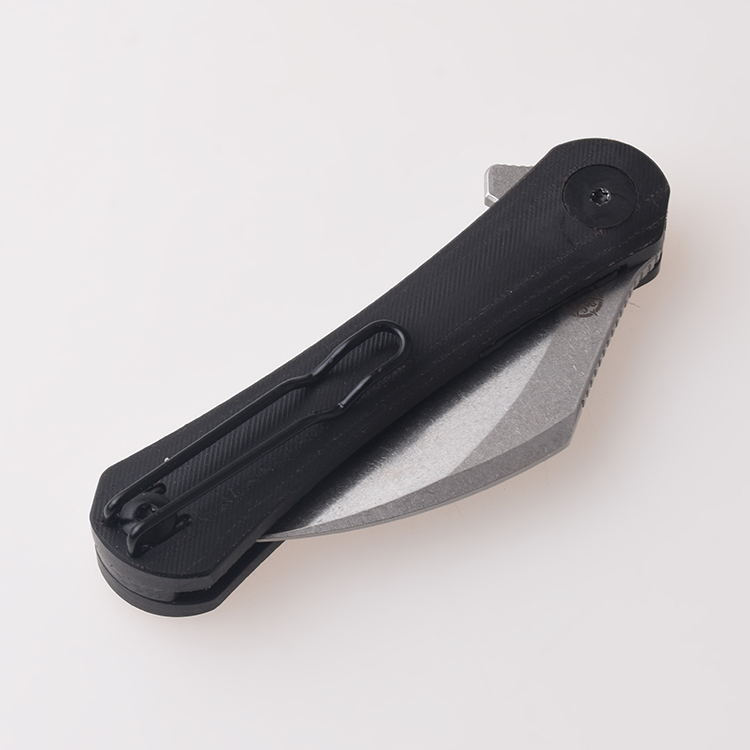
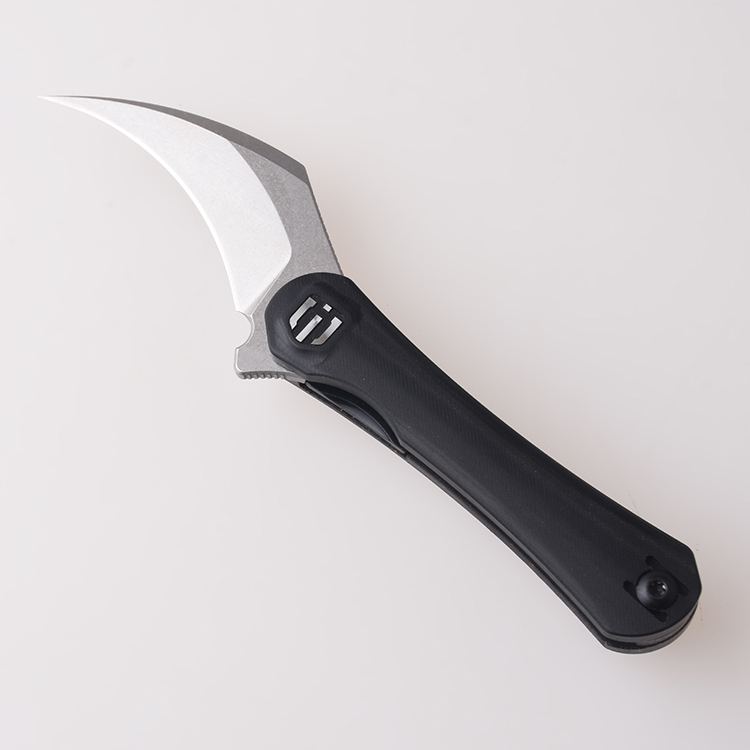
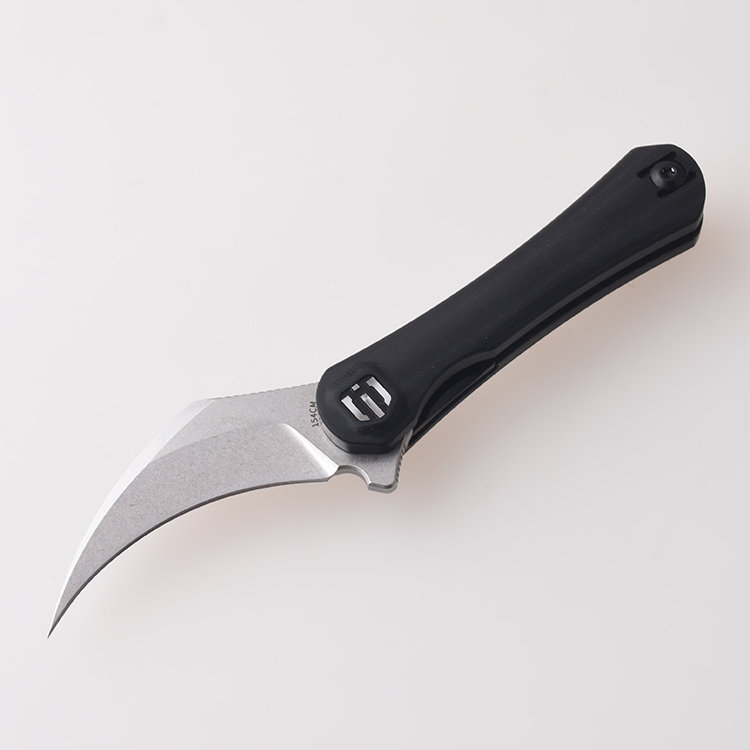
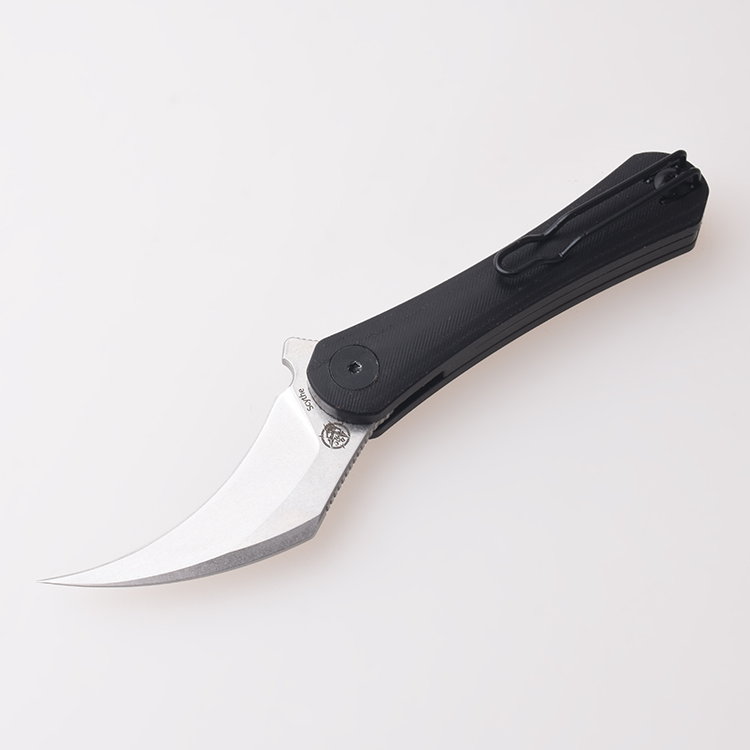
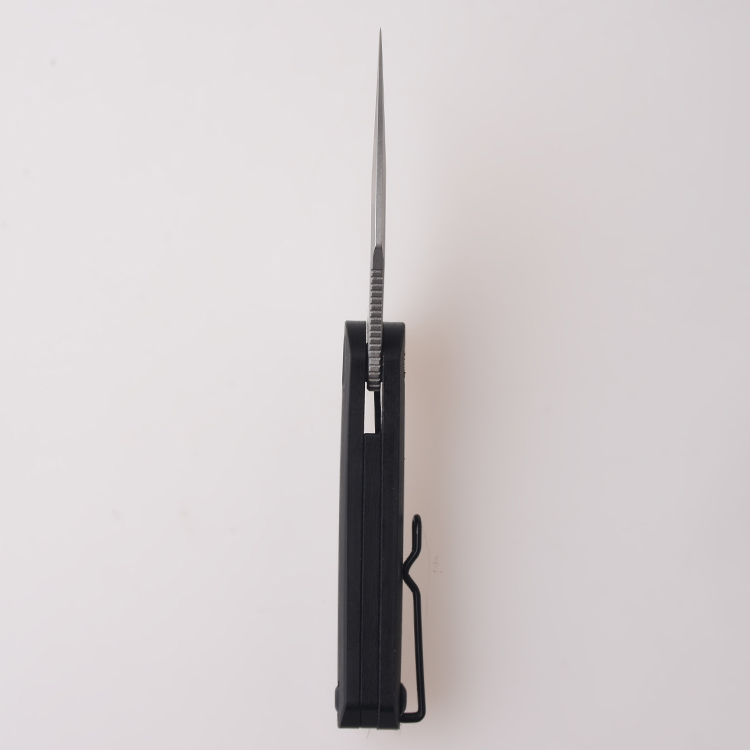
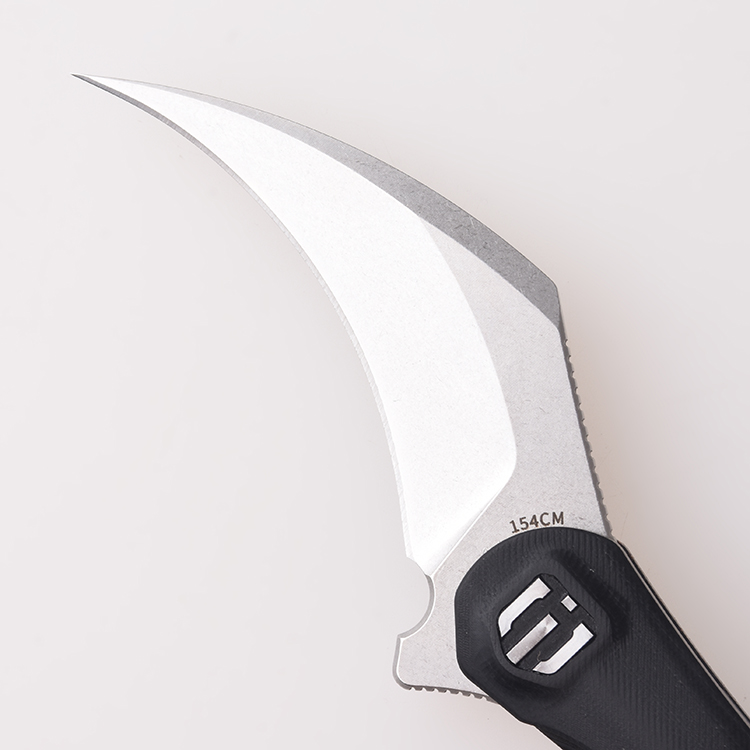
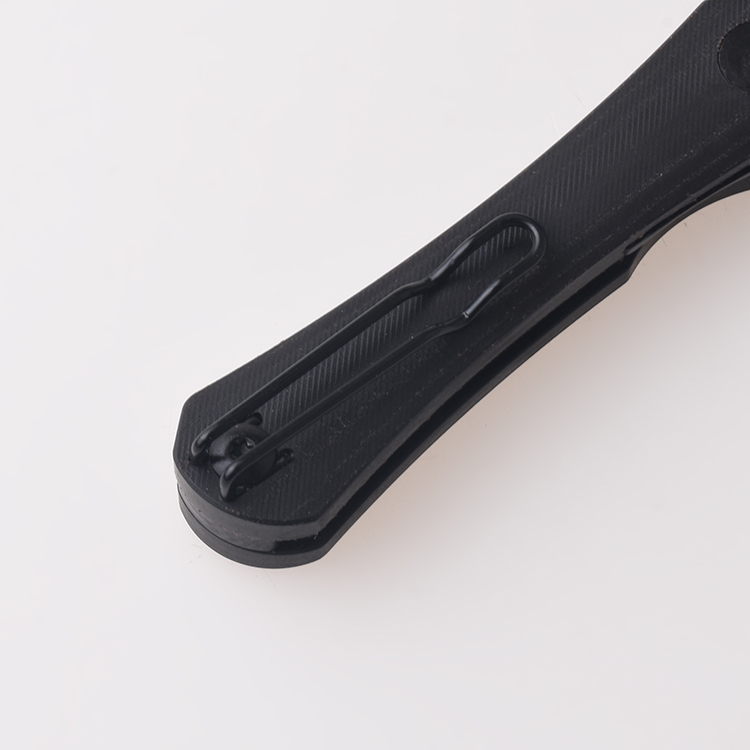
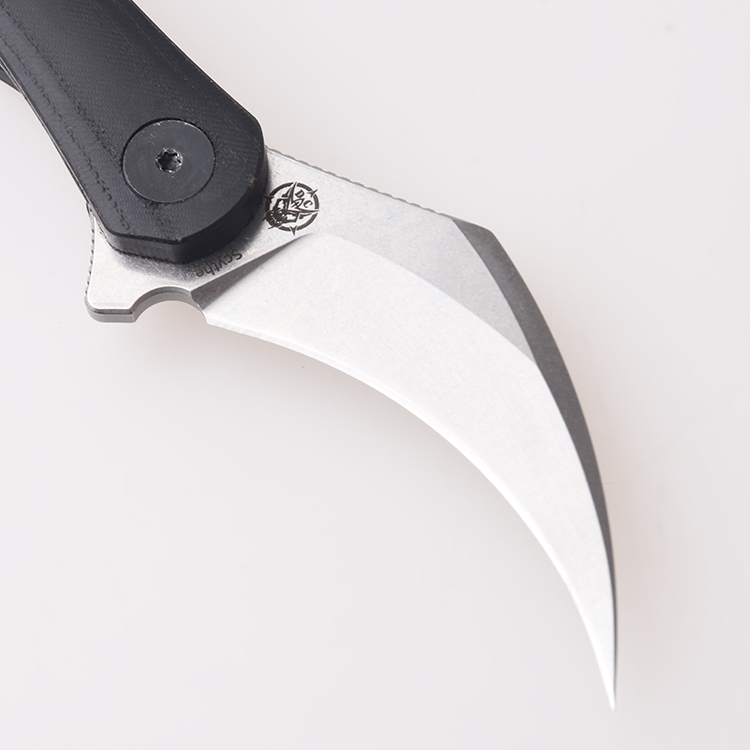
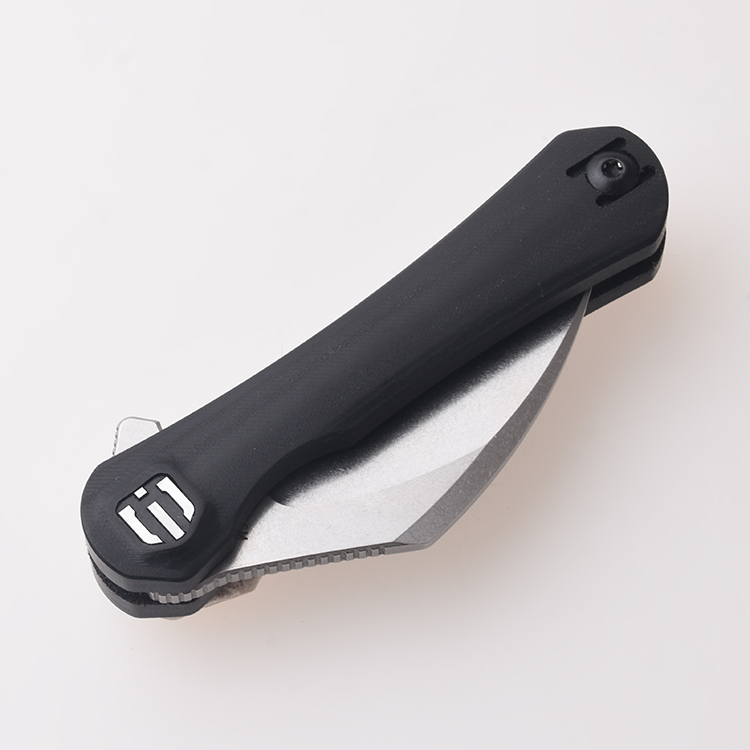
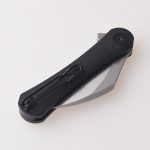
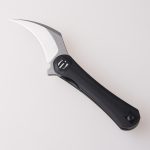
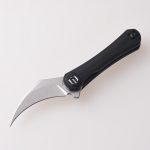
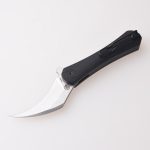
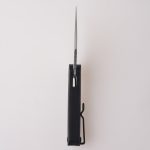
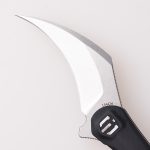
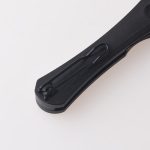

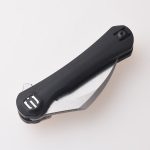
Item NO.: DC01A
Item segment: Crusader
Item name: Scythe
Designer: DC Blades (USA)
Blade material: 154CM
Handle material: Micarta + G10
Blade HRC: 58-60
Sharpened angle: 15-20
Blade thickness: 0.118”/3mm
Blade length: 2.55”/64.7mm
Handle thickness: 0.512”/13mm
Total length: 6.11”/155.2mm
Weight: 2.1 oz/59.5g
Main pivot hardware: T8
Assembly hardware: T8
Clip hardware: T8
Carry orientation: Right hand
Ball bearing: Caged ceramic
Blade style: Pikal
Handle color: Black
Pocket clip: Ambidextrous deep carry wire tip-up
Lock mechanism: Nested liner lock
Open way: Flipper + flick
Blade finish: Stonewash
Blade grind: Flat
UPC: 663376699669
MAP (USD $): 65
MSRP (USD $): 89
Introducing the Scythe, a cutting-edge marvel in the realm of knives, poised to revolutionize the current market.
Crafted by the renowned team at DC Blades and Shieldon Knives, this exceptional EDC folding knife boasts a scythe-like blade point that sets it apart from its counterparts.
With a compact and sleek design, measuring a mere 6.11 inches (155.2mm) in overall length, the Scythe embodies both form and function.
Its name pays homage to the iconic Death Scythe wielded by the Grim Reaper, capturing the essence of its formidable power in every aspect of its creation.
Prepare to embrace a new era in knife craftsmanship with the Scythe.
The DC01A Blacksmith Scythe by Shieldon and DC Blades USA features a 154 CM blade, crafted for superior strength and durability.
This high-performance steel is renowned for its excellent edge retention and corrosion resistance, making it an ideal choice for EDC knives.
The blade also boasts a scythe-like point that gives it a unique aesthetic while providing exceptional cutting performance.
With its sleek design, the Scythe is sure to become your go-to knife of choice whenever you need precision cutting power in any situation.
The Pikal Point blade, highly coveted for its versatility, finds its niche in both carving and tactical applications.
Distinguished by its resemblance to the scythe-style point, the Pikal Point boasts even more acute angles, enhancing its ability to penetrate with remarkable precision.
This unique blade shape empowers the user with enhanced control, enabling effortless piercing and seamless slicing through even the most resilient materials.
Whether you seek finesse in delicate tasks or reliability in demanding scenarios, the Pikal Point blade stands ready to exceed your expectations.
The DC01A Blacksmith Scythe by Shieldon and DC Blades USA is equipped with a handle made of black micarta and G10, providing superior grip and comfort in any situation.
The combination of these two materials creates a unique texture that feels great in the hand while maintaining its durability under extreme conditions.
Additionally, the shape of the handle is designed to fit your palm perfectly giving you maximum control when using the knife for delicate tasks or demanding scenarios.
With its ergonomic design, this reliable EDC folding knife allows you to perform various cutting applications with ease and precision.
The knife is also equipped with T8 screw technology, allowing for effortless one-hand opening and closing.
Moreover, the nested liner lock ensures superior security in any situation.
One of the best accessories for this knife holder is the carry stainless steel wire clip that is ambidextrous and designed for easy portability.
You can easily attach the Scythe to your belt, pocket, or bag with its discreet black finish that won’t draw unwanted attention.
It also comes with a ceramic ball bearing, making it easier to open and close the knife blade even with one hand.
The DC Blades comprises two talented knife designers, Justin Carvin and Chris Harrison, who have been working together in the knife industry for many years.
When Shieldon, a knife manufacturer, initially approached DC Blades, they were delighted to collaborate with a new brand.
Justin, known for his amiable nature, shared his extensive knowledge of knife trends and market shifts.
As a knife collector, he was well-versed in the historical revolutions of knife design.
For Shieldon’s first royalty model, Justin presented a Pikal point fixed blade knife, which it was then Shieldon’s responsibility to transform into a folding knife.
Justin provided numerous ideas, including his desired color scheme and the overall essence he envisioned for the knife. Each designer possesses a unique connection to their designs, reflected in the knives’ DNA.
Initially, the Shieldon team had reservations, questioning the knife’s cutting and slicing capabilities and how it should be used. To address these concerns, they embarked on creating a structural image based on the photo provided by Justin.
After spending several days immersed in drawing and design, the Shieldon team finally created the initial structure of the folding knife in a CAD file.
However, there was an underlying uneasiness about the drawing that we couldn’t quite put into words.
Sometimes, when you’ve been involved with knives for years, you develop an instinctive feeling about the quality of a knife just by looking at it for the first time. In this case, that feeling persisted as we examined the embryonic form of our folding knife.
Shieldon’s team understood that if something didn’t feel right about a knife at first glance, it likely wouldn’t translate into a good knife overall.
With this realization, Shieldon’s team was determined to fine-tune the design and make the necessary modifications to ensure a superior end product.
A knife is a group of various components, ranging from the blade to the handle, and from the inner mechanisms to the outer screws.
This principle applied not only to the physical structure but also to the drawing process itself.
Each component was carefully isolated, allowing us to redefine its size and shape, ensuring that each element met our highest standards
Drawing served as the crucial initial step in the knife-making journey. The quality of the drawing directly influenced the overall shape of the knife.
Hence, it demanded our undivided attention. It was imperative to achieve a seamless transition between the blade and the handle, ensuring that the handle provided adequate coverage for the blade, especially its sharpened edge.
However, Shieldon also had to strike a delicate balance, avoiding designs that were too large or too small, as it would compromise both ergonomics and aesthetics.
The art of crafting knives proved to be far from easy, requiring meticulous attention to detail every step of the way.
After multiple rounds of adjustments and precise measurements, the final dimensions of the Scythe became apparent.
With an overall length of approximately 6 inches, we acknowledged that it might be slightly short for individuals with larger hands.
However, the expert team firmly believed that this size would prove sufficient for most users.
In the upcoming design, Shieldon is incorporating a flipper tab into the blade, enabling swift and effortless opening with a simple press of a finger.
This innovative addition serves a dual purpose, not only facilitating rapid deployment but also providing a protective shield for your hand when the knife is fully opened.
With the introduction of the flipper tab, we aim to enhance both the speed and safety of using our knife.
In its closed position, the knife features a conveniently positioned flipper tab, which incorporates subtle jimping on one side.
This design enables effortless opening by simply pushing the flipper tab with the index finger, ensuring a smooth and user-friendly experience.
With this functionality established, we have nearly finalized the general size of this model.
Moving forward, the expert’s focus shifts to modifying the overall structure of the knife to ensure optimal ergonomics.
Shieldon understands the significance of creating a knife that not only performs well but also feels comfortable in the hand.
Through meticulous adjustments and careful attention to detail, Shieldon Knife is dedicated to refining the knife’s structure to achieve the perfect balance of functionality and ergonomic excellence.
Attention must be given to the placement of the sharpened edge when the knife is in the closed position.
Currently, it extends dangerously close to the handle, posing a potential risk and lacking sufficient security for users
To address this concern and ensure the knife’s safety, modifications need to be made to the pivot turning mechanism.
By allowing the blade to retract slightly deeper into the handle, we can achieve a crucial objective: rendering the sharpened edge completely concealed when the knife is closed.
The qualification of a knife lies in its ability to prevent any visibility of the sharpened edge from the outside when in the closed position. This essential adjustment not only enhances the knife’s overall safety but also assures users of a reliable and well-designed product.
The Pikal blade serves as the focal point of attraction in this knife, deserving special attention and recognition.
Drawing inspiration from the formidable Death Scythe of the Grim Reaper, our aim was to recreate its essence as faithfully as possible.
Naturally, the shape of the blade was also subject to the overall design and form of the knife.
By placing significant emphasis on the Pikal blade, we sought to capture its unique appeal and incorporate it harmoniously into the knife’s aesthetic and functionality.
This deliberate focus on the blade shape ensures that the knife maintains its captivating and distinctive character, paying homage to its inspiration while still fitting seamlessly within the overall design framework.
The Pikal Blade possesses a wealth of knowledge surrounding its advantages and disadvantages, providing ample material for passionate blade enthusiasts to discuss.
Undoubtedly, its unique blade shape renders it particularly suited for specific uses. However, it is not without its drawbacks. In this section, we will delve into a comprehensive examination of the pros and cons associated with the Pikal blade.
The distinctive characteristics of a Pikal blade include its inverse belly and hooked shape, reminiscent of the Pikal itself.
This unique configuration, with its hooked cutting edge and a sharp point, contributes to the blade’s unparalleled shape and renders it highly advantageous for certain cutting tasks.
Traditionally, the Pikal blade has found its utility primarily in tasks such as horticultural pruning of trees or small limbs, as well as cutting tough materials like rope, linoleum, carpet, and more.
However, while the Pikal blade boasts its unique strengths, it also carries its fair share of disadvantages.
The specific design limits its versatility in certain applications and may not excel in tasks that require a different blade shape or cutting style.
Therefore, a thorough exploration of the pros and cons of the Pikal blade is essential in order to make an informed decision about its suitability for various cutting needs.
The Pikal blade offers numerous advantages as a work knife, primarily owing to its inward curved belly.
This distinctive feature proves highly valuable when it comes to slicing tasks, enabling efficient cutting of various materials.
Whether it’s rope, fishing nets, carpet, sod, electrical wire insulation, or linoleum, the strong shape of the Pikal blade excels in tackling these and many other similar materials.
The unique curvature of the Pikal blade enhances its slicing capabilities, allowing for precise and controlled cuts.
This makes it an indispensable tool for tasks that require smooth and efficient slicing, providing the user with greater ease and effectiveness in completing their work.
With its versatile cutting power, the Pikal blade proves to be an invaluable asset in a wide range of professional and everyday applications, making it a favored choice for those seeking a reliable work knife.
Initially, both the designer and Shieldon envisioned a titanium handle with a frame lock mechanism.
However, concerns arose regarding the potential expense of this choice and the uncertain market reception for the distinctive blade design.
In order to mitigate risks and test the market’s response, a strategic decision was made for the initial production run.
To strike a balance between functionality and market acceptance, the experts opted to utilize a liner lock mechanism instead of a frame lock.
This choice allowed us to reduce costs without compromising the overall quality and performance of the knife.
By making this calculated adjustment, Shieldon aimed to gauge the market’s interest and gather valuable feedback to guide future iterations.
For avid enthusiasts of Shieldon Knives, it is well known that all Blacksmith models feature a unique construction known as the nested liner lock.
Distinguishing itself from the conventional liner lock, this design incorporates an inlaid liner within the scales of the knife.
This intentional arrangement serves multiple purposes, including weight reduction, enhanced liner protection, and the creation of a sleek and fashionable knife profile.
Adhering to a consistent brand image, Shieldon Knives proudly employs the nested liner lock across its product line.
Presented above is a detailed diagram illustrating the intricacies of the nested liner lock. The diagram highlights the specific construction elements employed, showcasing the meticulous attention to detail in its design.
Upon closer inspection, it becomes evident that the Micarta scale has been skillfully hollowed out, creating a precise space that perfectly accommodates a stainless steel liner.
This intricate configuration shows dedicated time and effort in both structural drawing and machining, elevating the nested liner lock to a higher level compared to other conventional liner lock knives.
Symmetry is a key feature of the nested liner lock, with identical liners positioned on both sides of the knife.
Furthermore, at the center, a long backspacer extends nearly to the pivot point, further contributing to the overall stability and strength of the knife’s construction.
This deliberate arrangement of components showcases the commitment to precision and craftsmanship in creating the nested liner lock mechanism.
By providing this comprehensive visual representation, knife experts like us gain a deeper understanding of the complexity and sophistication that goes into the creation of the nested liner lock.
Shieldon Knives’ dedication to excellence is clearly demonstrated in the meticulous design and meticulous execution of this advanced locking mechanism.
A notable feature present in all Shieldon EDC Knives is the inclusion of skeletonized liners.
However, a common question arises regarding the impact of the five holes present in the stainless steel liner.
These holes serve the purpose of reducing weight, but the extent of weight reduction achieved may be a query for many.
In reality, the weight reduction achieved through these five holes is not substantial. Each individual hole typically weighs around 1 to 2 grams, resulting in a total weight reduction of approximately 7 to 9 grams when all five holes are considered.
Nevertheless, this reduction is significant enough to ensure a lightweight experience. It is worth noting that such folding knives generally weigh less than 70 grams, allowing for ease of carry and enhanced portability.
By incorporating skeletonized liners, Shieldon EDC Knives demonstrate its commitment to innovation and design efficiency.
The strategic removal of excess weight through these carefully placed holes strikes a balance between maintaining structural integrity and reducing overall weight, resulting in a highly functional and lightweight tool for everyday carry.

Within the realm of folding knives, particularly in the realm of high to premium-level EDC folding knives, the pivot assumes a crucial role.
Serving as a vital component, it directly influences the initial impression formed by knife users, showcasing the knife’s overall quality. The tactile experience it offers is of utmost importance.
When grasping a knife, employing different grips such as forehand or backhand, and repeatedly opening and closing it through various methods, users gain valuable insights.
This hands-on exploration enables a certain level of understanding and preference for the knife.
Recognizing the significance of the pivot, Shieldon emphasizes the attention to detail and craftsmanship associated with this essential component.
By ensuring a smooth and satisfying operation, Shieldon EDC folding knives strive to create an enjoyable and comfortable user experience, reflecting the brand’s commitment to quality and customer satisfaction.
Originally, the Scythe knife had a black titanium-coated deep carry tip-up clip.
However, during the development phase, the designer recommended transitioning to a wire clip for mass production.
The wire clip was chosen because it offers a more comfortable grip with fewer pressure points.
This change was made to align the Scythe’s design and enhance user comfort. As a result, Shieldon decided to switch to a wire clip, ensuring a better overall experience for users.
After extensive development, the drawing for the Shieldon Scythe was nearly finalized.
This remarkable knife boasted a Pikal blade, transitioning from a fixed model to a folding one, with an overall length of 6.11 inches (155.2mm).
To ensure versatility, it featured an ambidextrous and reversible wire clip, complemented by a sleek black titanium coating.
With these exceptional features, we were confident that the Shieldon Scythe would make a significant impact in the market.
The Shieldon Scythe marked the introduction of the Pikal shape to Shieldon Knives’ product line.
Throughout the CAD drawing process, the esteemed designers, Justin Carvin, and Chris Harrison, provided invaluable suggestions and guidance. Their expertise enriched our knowledge and helped us further refine the design.
With the Shieldon Scythe, we embarked on a journey of innovation, setting new benchmarks in knife design.
It’s exceptional features and collaborative design process have equipped us with invaluable lessons and insights for future endeavors.
Behold the rendering image of the Shieldon Scythe! Inspired by the iconic Death Scythe, Shieldon, and DC Blades meticulously crafted this design to evoke a similar sense.
With a focus on aesthetics, we opted for a black handle, accompanied by black screws and a black wire clip.
This bold choice creates a striking contrast with the satin blade, resulting in an eye-catching appearance.
In our quest for versatility, we incorporated an ambidextrous/reversible wire clip into the Shieldon Scythe.
To accommodate this feature, we created a dedicated clip groove of just the right size to securely hold the wire clip in place.
Unlike standard stainless steel clips, the clip screw in the Shieldon Scythe is larger, ensuring a sturdy attachment.
While a single screw may not provide optimal fastening for the clip, it is sufficient to maintain the wire clip’s functionality and regularize its position.
If you’re eager to see the actual knife or get a glimpse of the physical product, stay tuned for our latest updates on the Shieldon Scythe!
We are ready to help at any stage of your OEM knife project. Send us your enquiry and your budget and we will get back to you within 24 hours.